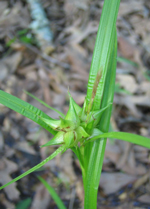Freshwater Marshes

The greater bladder sedge (Carex intumescens) can be found
in meadows and swamps in the eastern regions of Texas.
Photo courtesy Jennifer Key, TPWD 2004, Angelina County
Freshwater marshes are nonforested, nontidal wetlands dominated by grasses, sedges, and other freshwater emergent plants. They can occur in low depressional areas in the Gulf Coast region, in shallow water along lakes, rivers, or streams, or can exist as abandoned oxbows. Freshwater marshes are highly productive ecosystems and can sustain a wide variety of plant communities, and therefore provides diverse habitat for wildlife. In addition, the flat nature of most marshes help in mitigating flood damage and filtering excess nutrients from surface runoff.